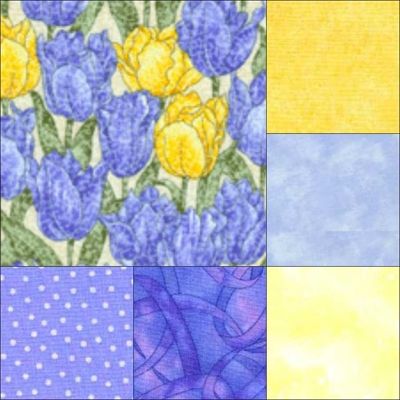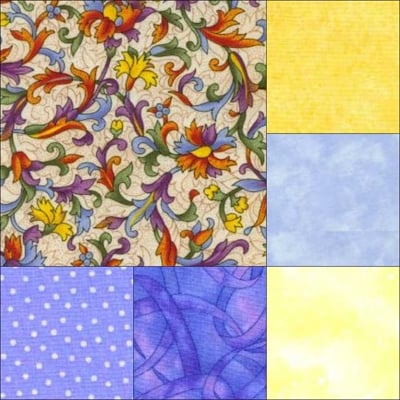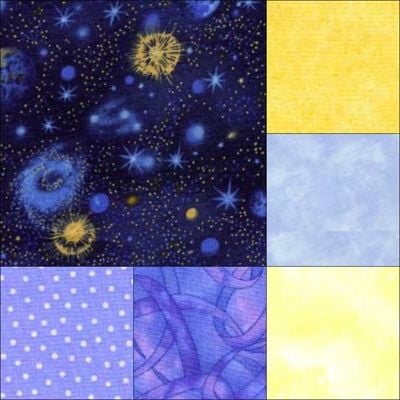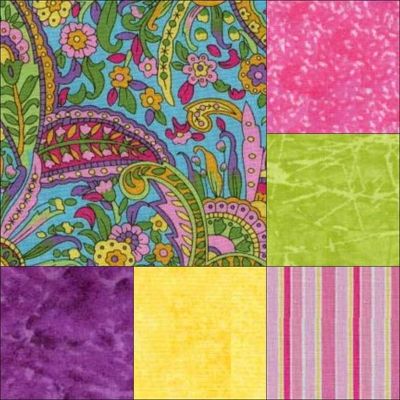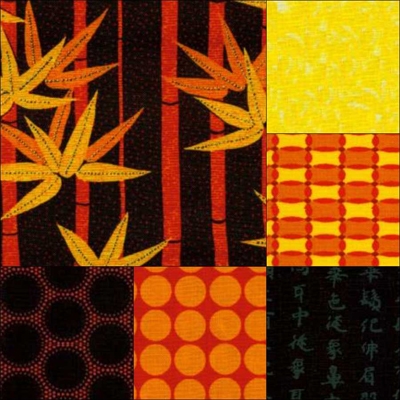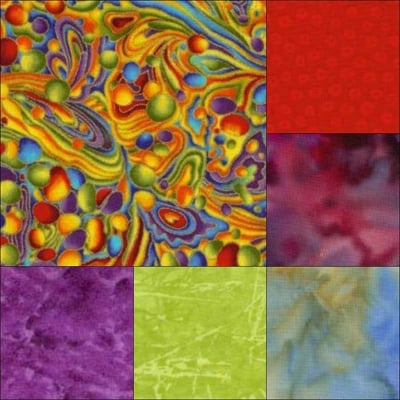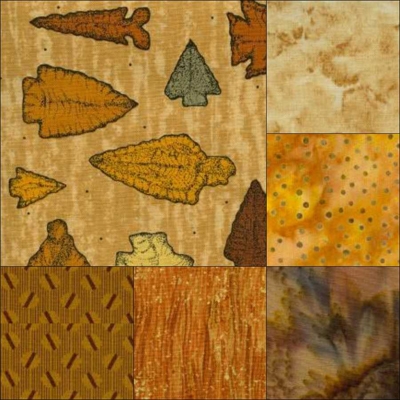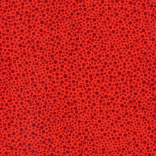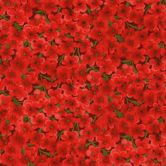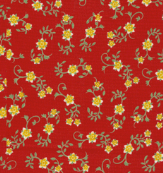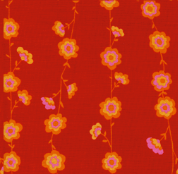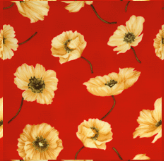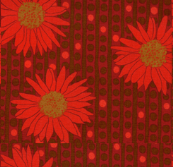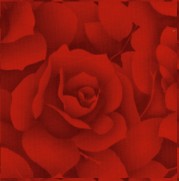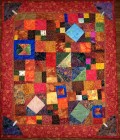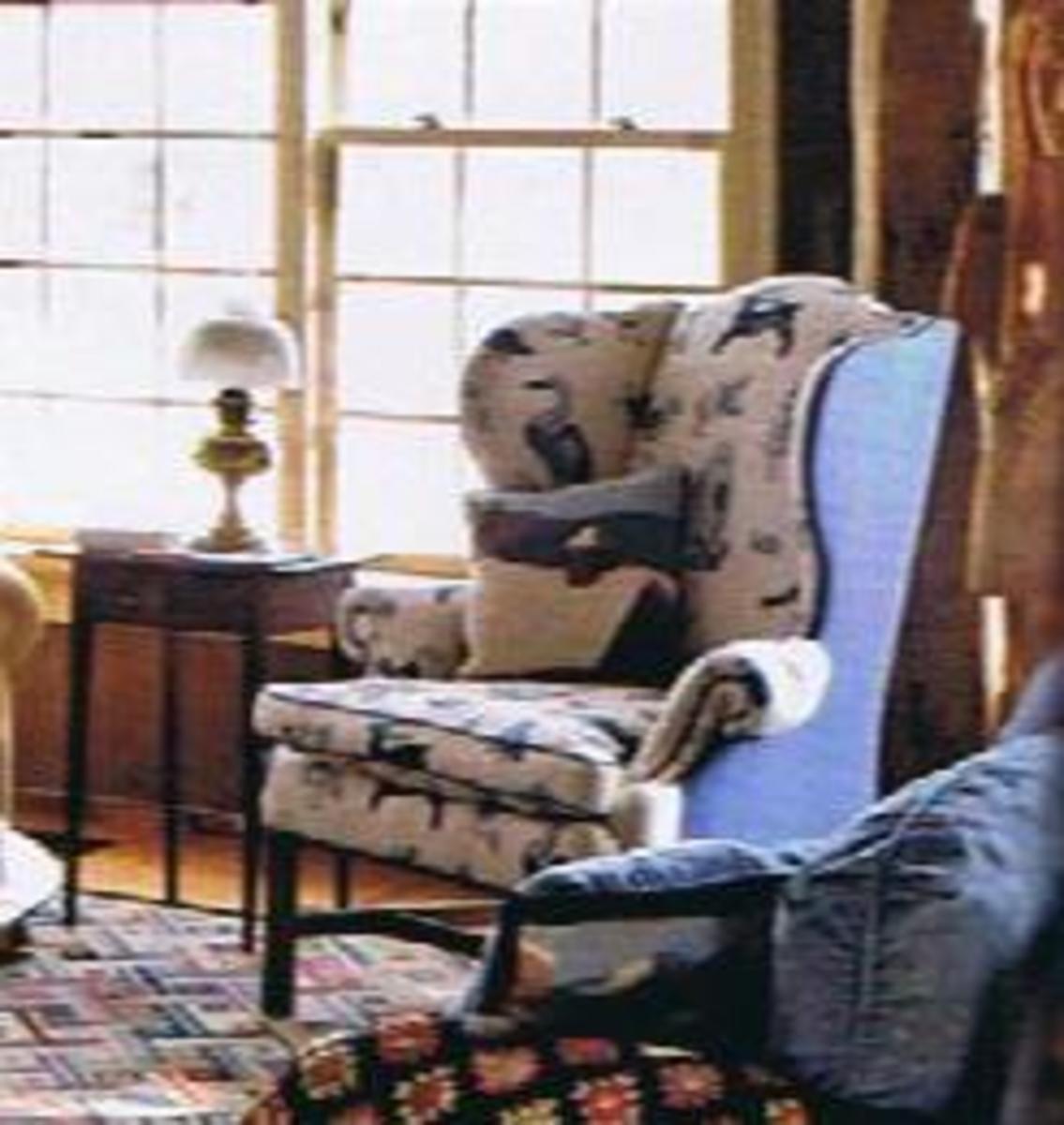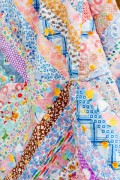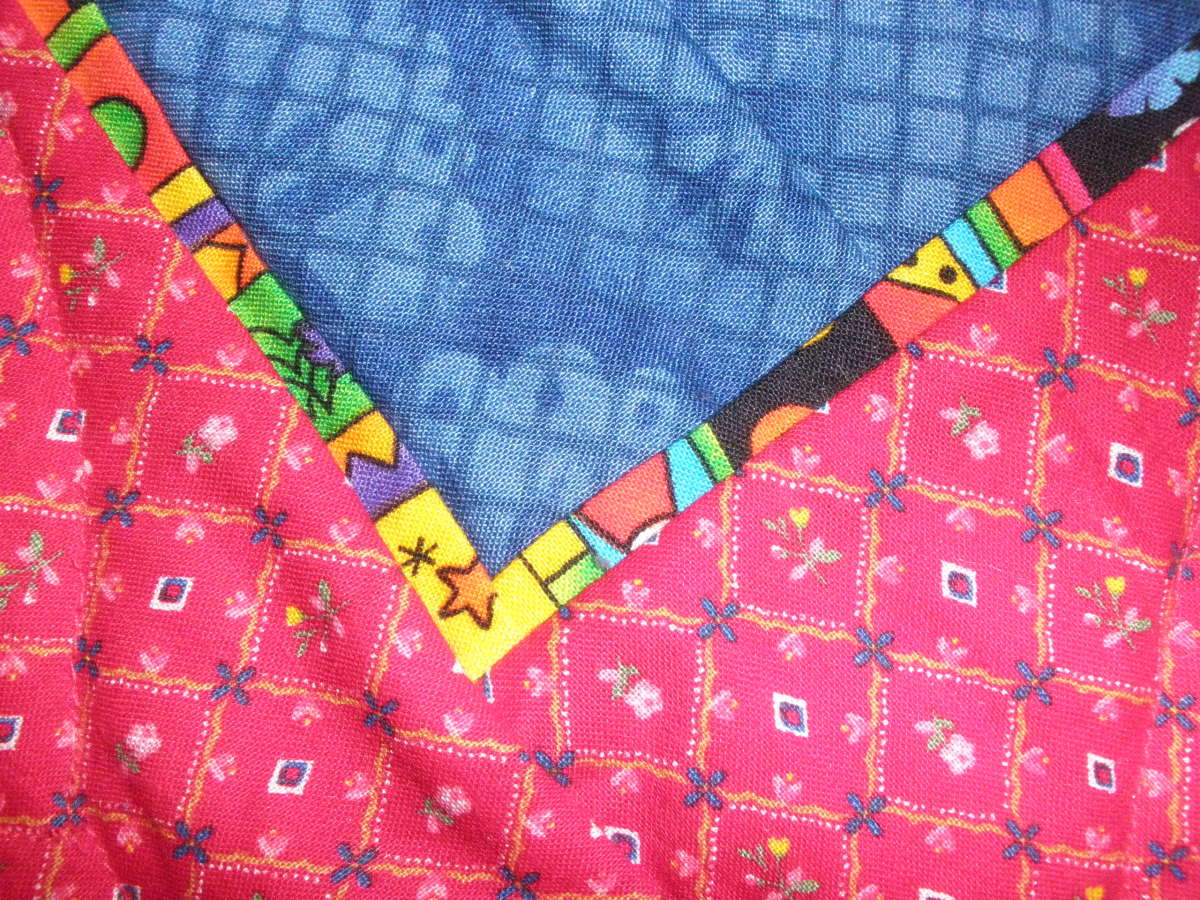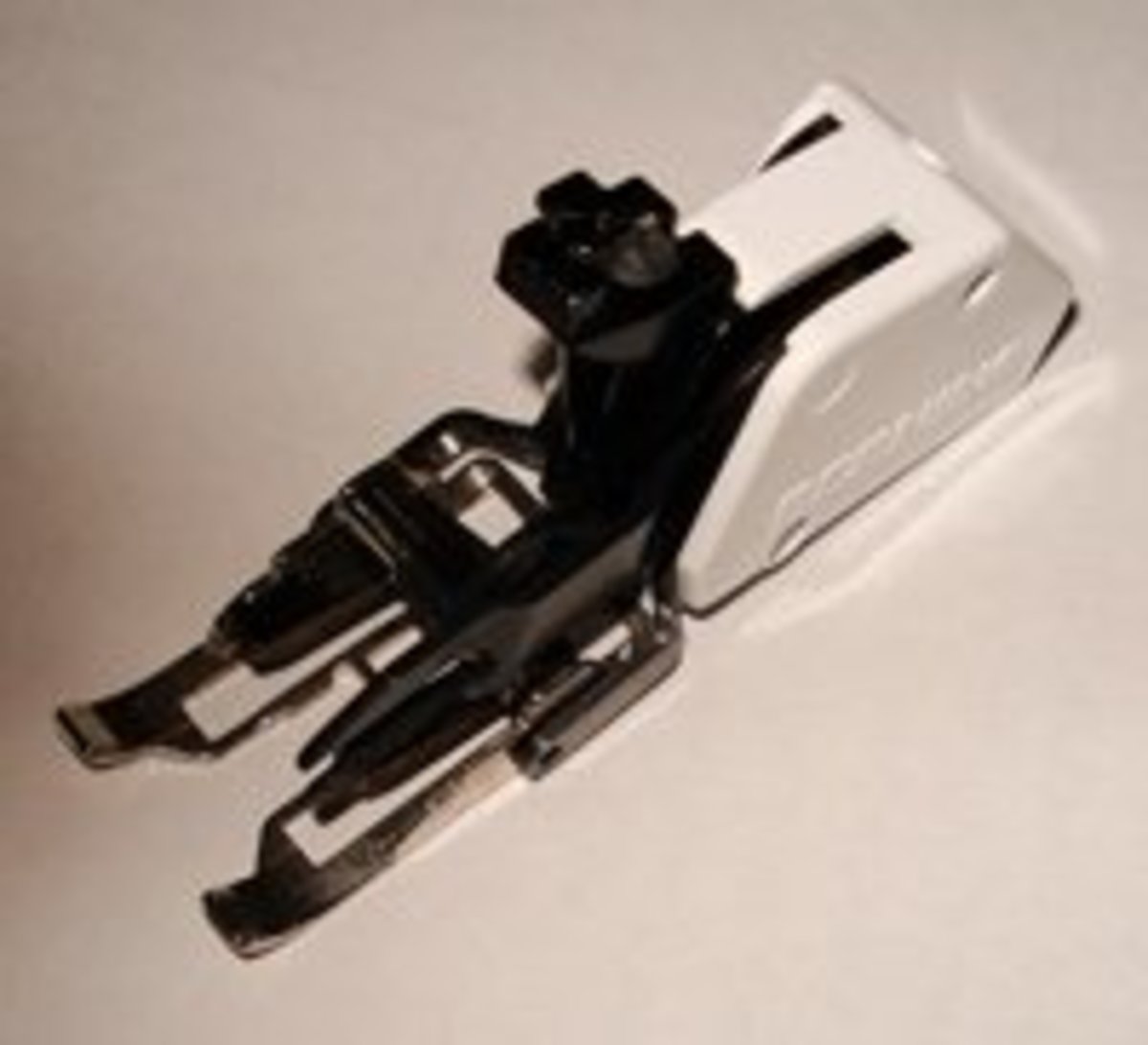Choosing fabric for patchwork
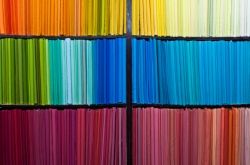
Fabric for your next quilt
How do you pick from the thousands of fabrics that are out there?
Isn't it scary when you first go into a patchwork shop?
There's so many patterns, fabric types, colours. How do you decide?
You thought you knew exactly what to buy, and now...
What fabric can you make a quilt from? - a few suggestions
There's no rules really.
I have used silk, Vyella® — a lightweight wool blend, and cotton all in the same quilt — my first quilt.
The silk is wearing out, but all the others are still going fine.
- 100% cotton
- polyester/cotton mix
- silk
- velvet
- rayon
- satin
- lurex
- polished cotton
- sheeting
- curtaining
- the best bits of an old favourite dress
What's the best fabric to buy?
for patchwork
There are no hard and fast rules.
You will find it easier to work with the specialty patchwork fabrics that are available from large fabric retailers and from quilt shops.
Hand quilters need hand — the drape or feel of the fabric — but machine quilters can use anything, because they don't have to push a tiny hand quilting betweens needle into it.
In days gone by, patchworkers used whatever they could get their hands on, be it dress fabric, sheeting, shirt sleeves from old shirts, scraps from children's dresses...
For precious heirloom quilts, they often used silk, or purchased fabric to use in the special quilt.
Nowadays we are spoilt for choice. The range of patterns that you can buy is enormous and can be daunting, even if you've been making quilts for ages.
There's too many to choose from.
The 'quilt police' will tell you it must be
100% cotton, but it's
completely up to you!
— Jan TFabric combinations - for you to observe the relationship between the palette fabrics.
Click thumbnail to view full-size






Should I buy the fabric for the back
at the same time as I buy the fabric for the top?
I never do that!
I join bits and pieces together for backs, even for my art quilts.
In some circles they call this 'back art'.
I do buy fabric especially to match the front, but not often.
I did buy an expensive Jinny Beyer designer fabric for the back of In Joyful Strains, and no-one ever sees it!
After the top is finished, I decide what I want to do. My little grand-daughter's quilt is totally different on the back from the front, so she can have it reversible when she's a bit big for the babyish stuff on the front.
Where do you start?
With a focus (feature) fabric
Have you ever seen a wonderful fabric that just wanted you to buy it?
That's because you like the style of the print, the colour combination that the fabric designer has used, and the proportions he/she used for those colours in when designing the fabric.
When you want a ready-made palette, just pick the main fabric, then use that for your palette choices.
In the gallery below, I used from swatches from Electric Quilt, quilt design software, to show how you can choose the same set of co-ordinating fabrics to match several different feature fabrics. The results are quilte different from each other.
Some fabric company websites - to whet your appetite
- Welcome to Timeless Treasures Fabrics, Inc.
Timeless Treasures Fabrics, Inc. has been the leading producer of innovative fabrics for over 30 years. Timeless Treasures offers top quality, 100% cotton designs to the quilting, craft and apparel communities. - Makower Uk Ltd - designers and producers of cotton fabrics for quilters
Makower Uk Ltd - designers and producers of cotton fabrics for quilters - Skydyes - Hand Painted Cottons and Silks for Quiltmakers and Fiber Artists
Imagine the Possibilities with hand-painted cottons by Mickey Lawler. Each piece of fabric is painted individually to suggest textures, skies, landscapes, moods, with subtle and rich color nuances. - Hoffman Fabrics makes quality hand-dyed, handpainted Bali batiks and designer screenprint fabrics fo
Quilters and sewers come�to Hoffman Fabrics for the best in original screenprints and hand-dyed batiks and handpaints.�As a wholesale converter of the highest-quality cotton and blen - RJR Fabrics
RJR Fabrics is one of the world's leading manufacturers of high-quality fabric designed exclusively for the crafting of quilts and home sewing. RJR specializes in the production of 100% cotton fabrics, brushed flannels, cotton sateens, and specialty - Kona Bay Fabrics..pampering fabric lovers since 1991
Aloha from Hawaii!! Kona Bay Fabrics has been offering quilters, fabric lovers, crafters, and sewing enthusiasts a wide array of gorgeous fabrics since 1991.
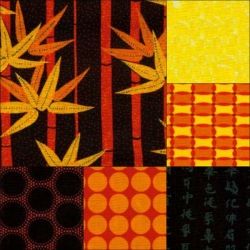
Quilt palettes
to make your next quilt top
The fabric set that you choose for your quilt is like the paints or pencils that an artist uses to paint a picture.
That's what you are: a quilt artist.
To 'paint' your patchwork blocks, you need a palette.
Make your own quilt palette
Are you ready to choose?
Start by getting that fabulous fabric that you love out of your stash.
Carefully examine the colours and how much of each colour is in the design. Some fabrics have a little row of circles on the selvedge with the colours from the print in them, which is a good start if you are not confident enough yet.
That still doesn't help with the amount of each colour.
Now you need to see how much of the brightest colour there is, and how much of the strongest — the one that jumps out at you.
Find some fabrics from your stash that you think will work. Arrange them on your bench in an overlapping pile, so that a small amount peeps out of the colour that is the least in the print, and a large amount is showing of the one that is the most.
Is that helpful?
If you take a photo of that set of fabrics and then try a different combination of the amounts you let peep out in the stack, and take a picture of that set, you can compare the two (or three) palettes that you worked up.
Tiny, small, bigger, bigger, biggest
Click thumbnail to view full-size






What size print is best?
Good question!
The design on the fabric can be big, small, giant, tiny, mid-sized.
The scale of the print is fairly important, as to how you can use it in a quilt.
A good rule of thumb is to have a mix of scales so that the eye has a point of comparison. If you have chosen a small-scale floral, team it with a larger one for contrast.
Add some 'tone-on-tone' prints to your palette for restful areas. These are prints, big or small, where the colours used in design vary little in value from one to the other, making the fabric appear to be a solid colour.
It is not generally good to make a quilt using all the same sized prints on the fabrics because they will have no definition and the end result may be unsatisfying.
Choose your fabric yourself
Be confident that you can.
When you go into a fabric store, especially a patchwork fabric shop, the assistant may want to help you choose.
While that can be helpful, I always tell my students when they ask me what to use, that I never have to look at the quilt again, they do!
Be confident that you have good colour sense — we all get ourselves dressed in the mornings and our clothes go together, don't they?
If you have difficulty deciding, ask can you have a small swatch or buy the minimum quantity you can and decide at home.
If you let yourself be swayed by someone else (even your buddy) you may regret it later.

